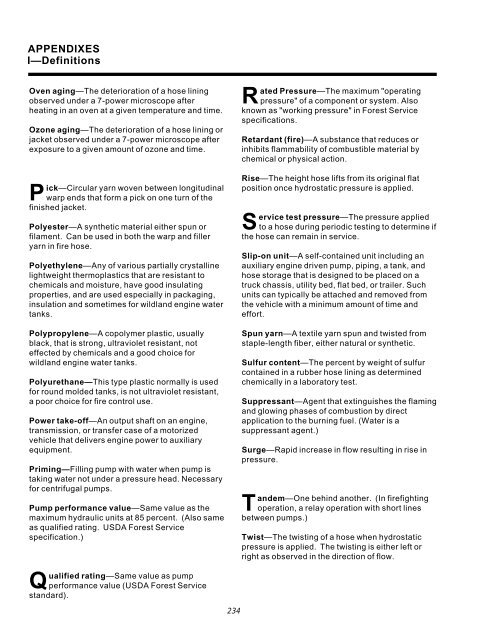Water Handling Equipment Guide - National Wildfire Coordinating ...
Water Handling Equipment Guide - National Wildfire Coordinating ...
Water Handling Equipment Guide - National Wildfire Coordinating ...
You also want an ePaper? Increase the reach of your titles
YUMPU automatically turns print PDFs into web optimized ePapers that Google loves.
APPENDIXES<br />
I—Definitions<br />
Oven aging—The deterioration of a hose lining<br />
observed under a 7-power microscope after<br />
heating in an oven at a given temperature and time.<br />
Ozone aging—The deterioration of a hose lining or<br />
jacket observed under a 7-power microscope after<br />
exposure to a given amount of ozone and time.<br />
Pick—Circular yarn woven between longitudinal<br />
warp ends that form a pick on one turn of the<br />
finished jacket.<br />
Polyester—A synthetic material either spun or<br />
filament. Can be used in both the warp and filler<br />
yarn in fire hose.<br />
Polyethylene—Any of various partially crystalline<br />
lightweight thermoplastics that are resistant to<br />
chemicals and moisture, have good insulating<br />
properties, and are used especially in packaging,<br />
insulation and sometimes for wildland engine water<br />
tanks.<br />
Polypropylene—A copolymer plastic, usually<br />
black, that is strong, ultraviolet resistant, not<br />
effected by chemicals and a good choice for<br />
wildland engine water tanks.<br />
Polyurethane—This type plastic normally is used<br />
for round molded tanks, is not ultraviolet resistant,<br />
a poor choice for fire control use.<br />
Power take-off—An output shaft on an engine,<br />
transmission, or transfer case of a motorized<br />
vehicle that delivers engine power to auxiliary<br />
equipment.<br />
Priming—Filling pump with water when pump is<br />
taking water not under a pressure head. Necessary<br />
for centrifugal pumps.<br />
Pump performance value—Same value as the<br />
maximum hydraulic units at 85 percent. (Also same<br />
as qualified rating. USDA Forest Service<br />
specification.)<br />
Qualified rating—Same value as pump<br />
performance value (USDA Forest Service<br />
standard).<br />
Rated Pressure—The maximum "operating<br />
pressure" of a component or system. Also<br />
known as "working pressure" in Forest Service<br />
specifications.<br />
Retardant (fire)—A substance that reduces or<br />
inhibits flammability of combustible material by<br />
chemical or physical action.<br />
Rise—The height hose lifts from its original flat<br />
position once hydrostatic pressure is applied.<br />
Service test pressure—The pressure applied<br />
to a hose during periodic testing to determine if<br />
the hose can remain in service.<br />
Slip-on unit—A self-contained unit including an<br />
auxiliary engine driven pump, piping, a tank, and<br />
hose storage that is designed to be placed on a<br />
truck chassis, utility bed, flat bed, or trailer. Such<br />
units can typically be attached and removed from<br />
the vehicle with a minimum amount of time and<br />
effort.<br />
Spun yarn—A textile yarn spun and twisted from<br />
staple-length fiber, either natural or synthetic.<br />
Sulfur content—The percent by weight of sulfur<br />
contained in a rubber hose lining as determined<br />
chemically in a laboratory test.<br />
Suppressant—Agent that extinguishes the flaming<br />
and glowing phases of combustion by direct<br />
application to the burning fuel. (<strong>Water</strong> is a<br />
suppressant agent.)<br />
Surge—Rapid increase in flow resulting in rise in<br />
pressure.<br />
Tandem—One behind another. (In firefighting<br />
operation, a relay operation with short lines<br />
between pumps.)<br />
Twist—The twisting of a hose when hydrostatic<br />
pressure is applied. The twisting is either left or<br />
right as observed in the direction of flow.<br />
234
















